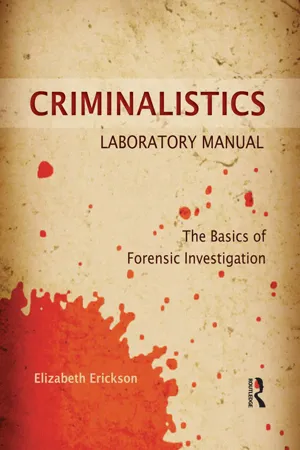
eBook - ePub
Criminalistics Laboratory Manual
The Basics of Forensic Investigation
Elizabeth Erickson
This is a test
- 226 pagine
- English
- ePUB (disponibile sull'app)
- Disponibile su iOS e Android
eBook - ePub
Criminalistics Laboratory Manual
The Basics of Forensic Investigation
Elizabeth Erickson
Dettagli del libro
Anteprima del libro
Indice dei contenuti
Citazioni
Informazioni sul libro
The Criminalistics Laboratory Manual: The Basics of Forensic Investigation provides students with little to no prior knowledge of forensic science with a practical crime scene processing experience. The manual starts with an original crime scene narrative setting up the crime students are to solve. This narrative is picked up in each of the forensic science lab activities, tying each forensic discipline together to show the integrated workings of a real crime lab. After the completion of all of the exercises, the student will be able to solve the homicide based on forensic evidence.
Domande frequenti
Come faccio ad annullare l'abbonamento?
È semplicissimo: basta accedere alla sezione Account nelle Impostazioni e cliccare su "Annulla abbonamento". Dopo la cancellazione, l'abbonamento rimarrà attivo per il periodo rimanente già pagato. Per maggiori informazioni, clicca qui
È possibile scaricare libri? Se sì, come?
Al momento è possibile scaricare tramite l'app tutti i nostri libri ePub mobile-friendly. Anche la maggior parte dei nostri PDF è scaricabile e stiamo lavorando per rendere disponibile quanto prima il download di tutti gli altri file. Per maggiori informazioni, clicca qui
Che differenza c'è tra i piani?
Entrambi i piani ti danno accesso illimitato alla libreria e a tutte le funzionalità di Perlego. Le uniche differenze sono il prezzo e il periodo di abbonamento: con il piano annuale risparmierai circa il 30% rispetto a 12 rate con quello mensile.
Cos'è Perlego?
Perlego è un servizio di abbonamento a testi accademici, che ti permette di accedere a un'intera libreria online a un prezzo inferiore rispetto a quello che pagheresti per acquistare un singolo libro al mese. Con oltre 1 milione di testi suddivisi in più di 1.000 categorie, troverai sicuramente ciò che fa per te! Per maggiori informazioni, clicca qui.
Perlego supporta la sintesi vocale?
Cerca l'icona Sintesi vocale nel prossimo libro che leggerai per verificare se è possibile riprodurre l'audio. Questo strumento permette di leggere il testo a voce alta, evidenziandolo man mano che la lettura procede. Puoi aumentare o diminuire la velocità della sintesi vocale, oppure sospendere la riproduzione. Per maggiori informazioni, clicca qui.
Criminalistics Laboratory Manual è disponibile online in formato PDF/ePub?
Sì, puoi accedere a Criminalistics Laboratory Manual di Elizabeth Erickson in formato PDF e/o ePub, così come ad altri libri molto apprezzati nelle sezioni relative a Law e Criminal Law. Scopri oltre 1 milione di libri disponibili nel nostro catalogo.
Informazioni
1
Laboratory #1 The Crime Scene Sketch
Chapter Outline
- 1.1 Crime Scene Sketches
- 1.2 Laboratory Exercise: Crime Scene Sketch
Learning Objectives
- Explain the various types of sketches
- Complete a rough sketch
- Complete a final sketch
- Demonstrate measurements within a crime scene
- Measure evidence using triangulation
What you will Learn
Laboratory #1, The Crime Scene Sketch, introduces the student to the various search techniques used for processing different types of scenes, such as indoor venues versus outdoor venues. The search techniques are explained with examples and suggestions for when to use one search technique over another. The use of triangulation is explained to measure evidence within a scene, which is also used for the laboratory exercise. Required information for a crime scene sketch is included with information on standard and military time conversions. The chapter ends with a laboratory exercise to show proficiency with creating a rough and final indoor crime scene sketch.
Key Terms
- demonstrative evidence
- elevation sketch
- enlarged sketch
- exploded sketch
- final sketch
- location sketch
- overview sketch
- rough sketch
Case File: 00-123456
After Officers Brown and O’Donnell realized that a double homicide had occurred, detectives, crime scene technicians, and the medical examiner were contacted for further processing of the scene. When the detectives arrived, the entire scene was cordoned off to prevent unnecessary people from entering and exiting in the hopes of preventing contamination. The detectives began to work on assessing the circumstances of the case and recreating the events that led to two deaths by interviewing witnesses, including Lynette Saunders.
While the detectives interviewed witnesses, the crime scene technicians and the medical examiner arrived to collect evidence from the scene. The crime scene technicians began to search the scene to locate possible evidence related to the homicide. The technicians located multiple pieces of evidence and placed yellow photo markers next to each item for future photographs, measurements, and finally collection.
The medical examiner checked each body and made observations about the location of each body and noted any outward signs that could assist with time of death determinations, such as rigor, livor, and algor mortis. Once the evidence was photographed around the body, the medical examiner took possession of the body for transport to the morgue.
Evidence Found at the Scene
The crime scene technicians found the following evidence at the crime scene:
- Multiple fingerprints located around the house and in the master bedroom
- Footwear impressions in blood located in the master bedroom and upstairs hallway
- Footwear impressions located outside the rear entrance to the Ashley residence
- Tool mark impressions on the outside of the rear entrance to the Ashley residence
- Red stains presumed to be blood located on the outside front stoop of the Ashley residence
- One blank pad of paper recovered from the kitchen counter
- Cigarette butts found outside at the rear of the Ashley residence
- One crowbar recovered from the master bedroom
- Two cartridge casings recovered from the master bedroom floor near William Ashley
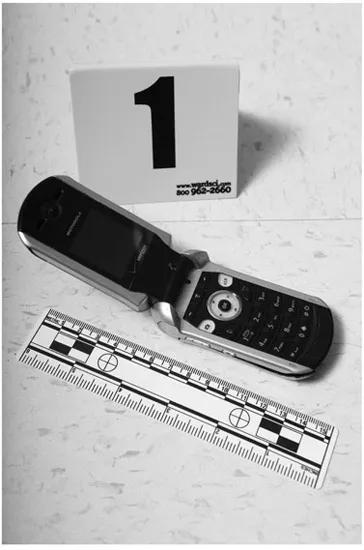
Cell phone found at the scene.
- Three cartridge casings recovered from the master bedroom floor near the foot of the bed
- Multiple hairs and fibers recovered from locations throughout the master bedroom
- Small piece of glass recovered from the master bedroom carpet
- Glass fragments located in the back hallway of the Ashley residence
- Small plastic bag containing a white powdery substance found on the front hallway floor
- Three empty pill bottles found on the upstairs hallway floor
- One pill bottle containing eight small blue tablets located outside in the bushes of the Ashley residence
- One diamond ring located outside on the ground
- One American Express card located outside on the ground
- One pair of black sunglasses located on the kitchen floor of the Ashley residence
- One cell phone located in the front hallway

Cartridge casings.
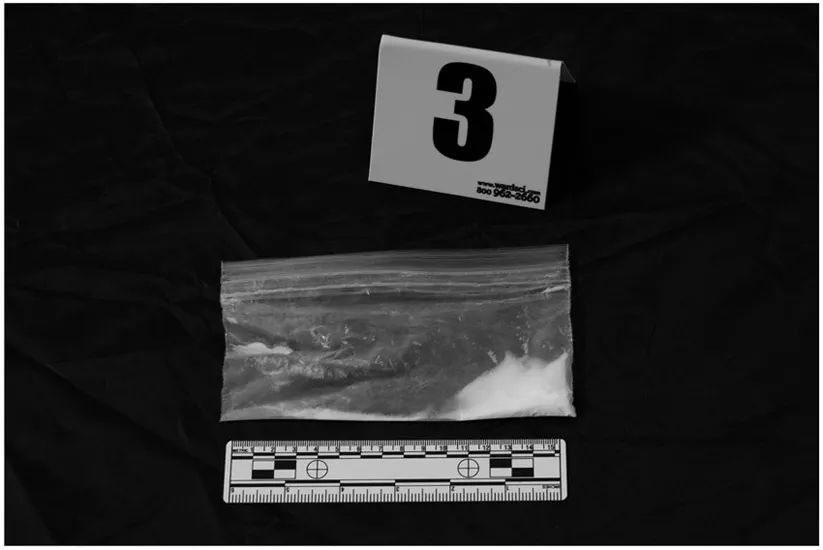
Small plastic bag containing white powder.
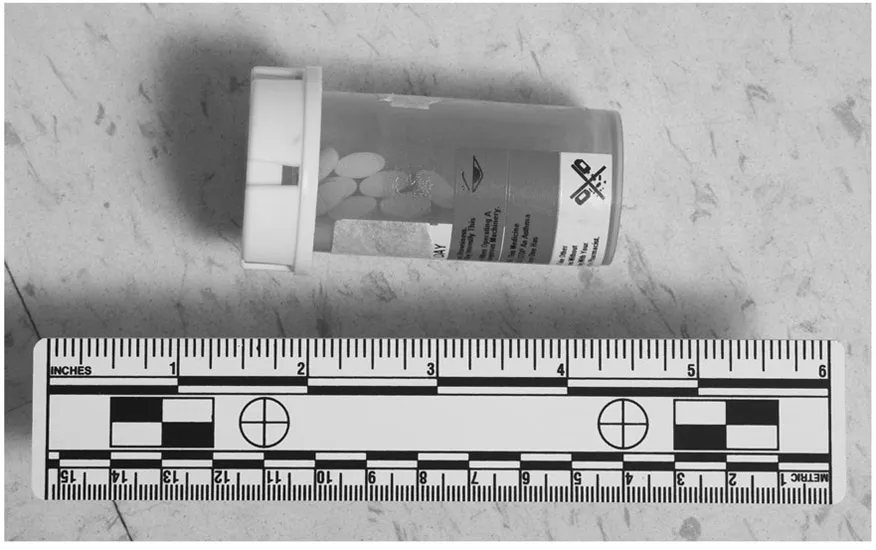
Pill bottle.
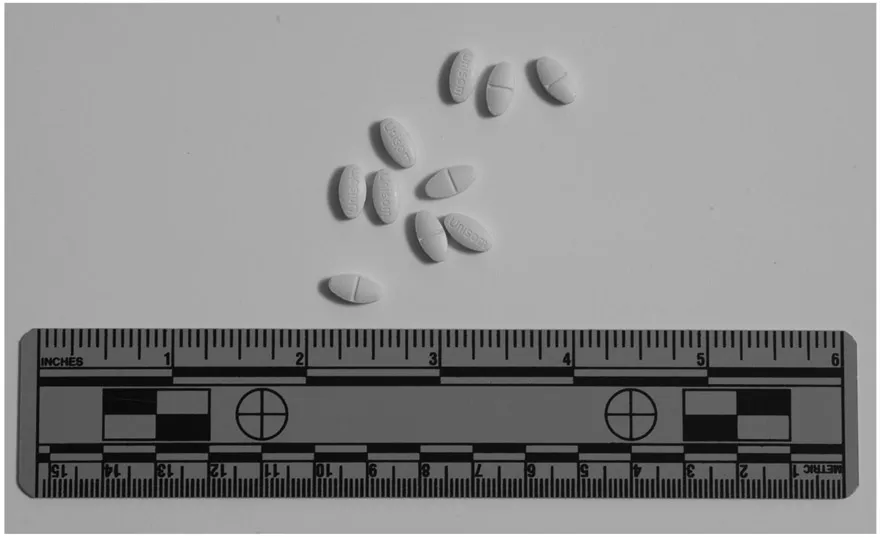
Pills.
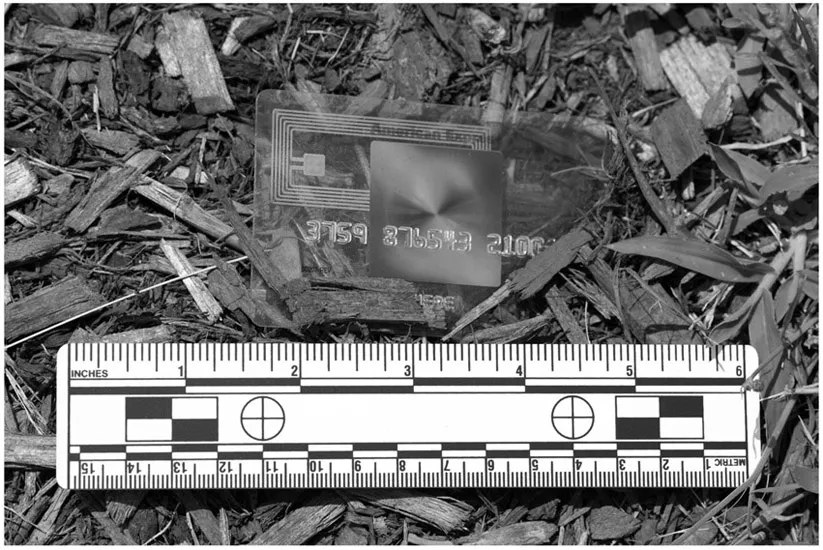
American Express card.
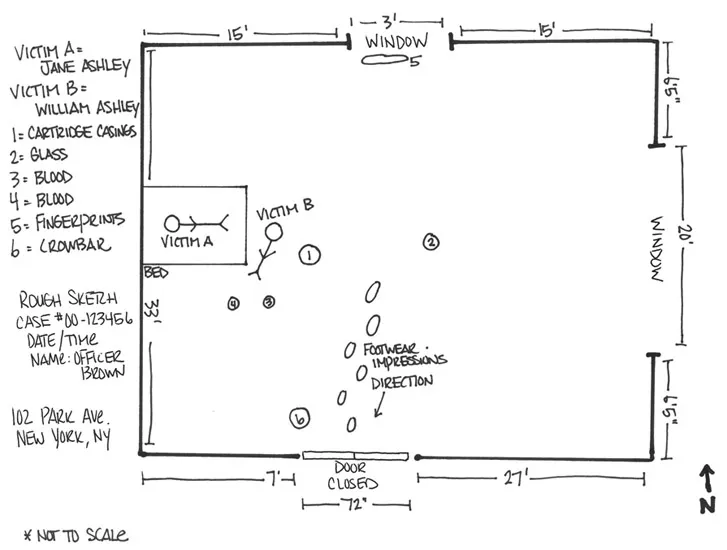
Sketch of where the bodies were located.
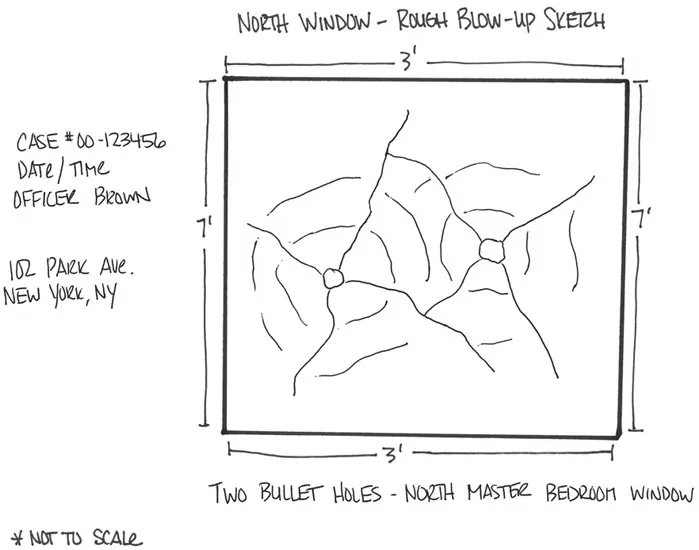
North window: Blown-up sketch.
1.1
Crime Scene Sketches
At major crime scenes, including homicides, a crime scene sketch must be made to accompany the pictures and the incident report describing the scene. The sketch is typically drawn by one of the technicians, but with recent technological advances, some departments have the capability of using crime scene sketching software to create a more realistic diagram for court presentation. Depending on the type of scene, multiple sketches would be completed to depict the entire area, specific locations with the body and/or evidence, location of events, etc.
Investigative Tip
A word processing program can be used to draw the basic perimeter of the c...
Indice dei contenuti
Stili delle citazioni per Criminalistics Laboratory Manual
APA 6 Citation
Erickson, E. (2013). Criminalistics Laboratory Manual (1st ed.). Taylor and Francis. Retrieved from https://www.perlego.com/book/1558772/criminalistics-laboratory-manual-the-basics-of-forensic-investigation-pdf (Original work published 2013)
Chicago Citation
Erickson, Elizabeth. (2013) 2013. Criminalistics Laboratory Manual. 1st ed. Taylor and Francis. https://www.perlego.com/book/1558772/criminalistics-laboratory-manual-the-basics-of-forensic-investigation-pdf.
Harvard Citation
Erickson, E. (2013) Criminalistics Laboratory Manual. 1st edn. Taylor and Francis. Available at: https://www.perlego.com/book/1558772/criminalistics-laboratory-manual-the-basics-of-forensic-investigation-pdf (Accessed: 14 October 2022).
MLA 7 Citation
Erickson, Elizabeth. Criminalistics Laboratory Manual. 1st ed. Taylor and Francis, 2013. Web. 14 Oct. 2022.